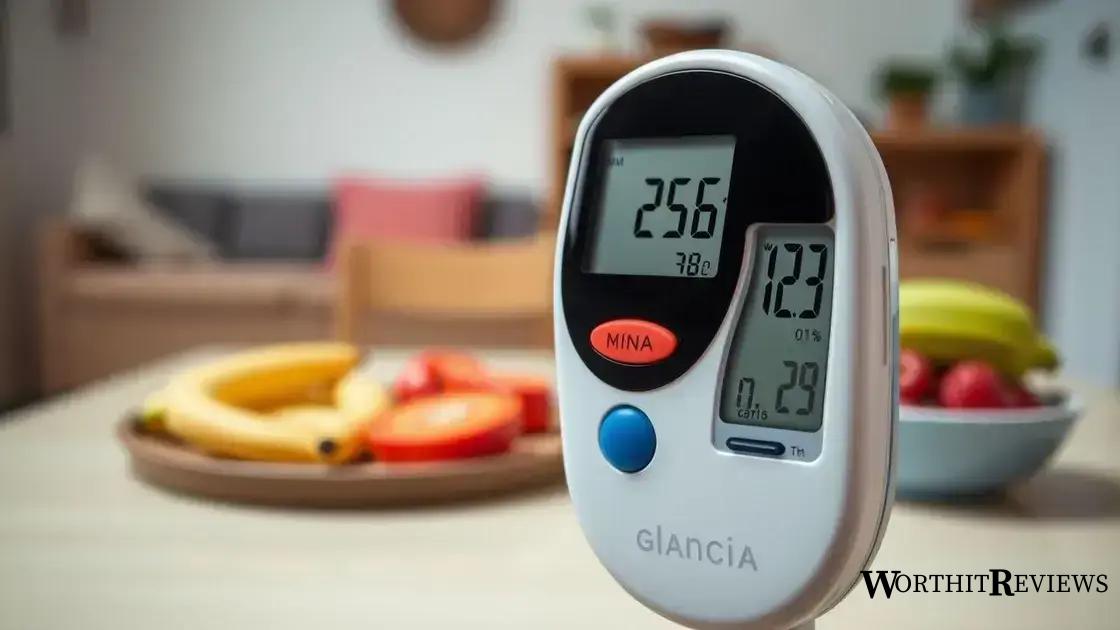To manage type 2 diabetes effectively, focus on balanced meals, regular exercise, and medications to maintain stable blood sugar levels while avoiding spikes by choosing low glycemic index foods and monitoring portion sizes.
Type 2 diabetes sugar levels are important for anyone navigating this condition. Have you ever wondered how your daily choices impact your health? Let’s dive into what you really need to know.
Understanding type 2 diabetes
Understanding type 2 diabetes is essential for managing your overall health. This chronic condition occurs when your body becomes resistant to insulin or when the pancreas cannot produce enough insulin. The result is elevated blood sugar levels, which can lead to serious health complications if left unchecked.
Many factors contribute to the development of type 2 diabetes, including genetics, lifestyle choices, and diet. For instance, being overweight or obese significantly increases the risk, as excess fat can interfere with insulin’s ability to regulate blood sugar.
Risk Factors
Some common risk factors include:
- Age: People over 45 are at a greater risk.
- Family History: Having a family member with diabetes increases your risk.
- Physical Inactivity: A sedentary lifestyle contributes to weight gain.
Symptoms to Watch
Recognizing symptoms can help in early detection. Common signs include:
- Increased thirst and frequent urination.
- Extreme fatigue and tiredness.
- Blurred vision and slow-healing wounds.
Monitoring your health and recognizing these symptoms can lead to earlier diagnosis and better management of this condition.
What are normal sugar levels?

Knowing what normal sugar levels are is crucial for managing type 2 diabetes effectively. Blood sugar levels are measured in milligrams per deciliter (mg/dL). Generally, normal fasting blood sugar levels should be between 70 and 99 mg/dL.
After eating, it’s normal for blood sugar levels to rise. A reading less than 140 mg/dL within two hours after eating is considered normal. However, if you have diabetes, your doctor will guide you on the target levels specific to your needs.
Understanding Blood Sugar Readings
Blood sugar readings can be categorized as follows:
- Normal: Fasting levels < 100 mg/dL; post-meal levels < 140 mg/dL.
- Prediabetes: Fasting levels 100-125 mg/dL; post-meal levels 140-199 mg/dL.
- Diabetes: Fasting levels ≥ 126 mg/dL; post-meal levels ≥ 200 mg/dL.
Why Monitoring is Important
Regularly checking your blood sugar helps manage diabetes by giving you insights into how food, activity, and medications affect your levels. Keeping your sugar levels within the recommended range can prevent complications such as heart disease, nerve damage, and kidney problems.
To maintain normal sugar levels, adopting healthy lifestyle habits is key. This includes eating a balanced diet, engaging in physical activity, and following your healthcare provider’s recommendations.
Factors affecting sugar levels
Several factors affect sugar levels, and understanding these can help individuals with type 2 diabetes manage their condition more effectively. Different elements can influence how your body produces and responds to insulin.
Diet is one of the most significant factors. Foods high in carbohydrates, especially refined carbs and sugars, can cause a rapid spike in blood sugar. In contrast, foods rich in fiber, healthy fats, and protein tend to have a gentler effect on blood sugar levels.
Physical Activity
Engaging in regular physical activity is crucial for maintaining healthy sugar levels. Exercise helps the body use insulin more effectively and can lower blood glucose levels. Even simple activities like walking, swimming, or dancing can make a difference.
Medications
For many, medications prescribed by healthcare providers also play a vital role in managing blood sugar levels. These can include oral medications or insulin therapy, depending on individual health needs.
Stress and Sleep
Stress and sleep patterns significantly influence blood sugar levels too. Stress hormones can raise glucose levels, while poor sleep can disrupt insulin sensitivity. Finding ways to manage stress through techniques like mindfulness or yoga can help keep sugar levels stable.
Being aware of how these factors interact can empower individuals to take proactive steps in their diabetes management. Keeping a detailed record of your food intake, activities, medications, and even stress levels can provide valuable insights to your healthcare team.
How to monitor your sugar levels

Monitoring your sugar levels is essential for managing type 2 diabetes effectively. It helps you understand how your body responds to various foods, activities, and medications. Here are some practical ways to keep track of your blood sugar levels.
Keep a Blood Sugar Log: Writing down your blood sugar readings can help identify patterns. Include the date, time, and any relevant factors such as what you ate and your physical activity. This log will provide valuable insights to discuss with your healthcare provider.
Use a Glucose Meter
A glucose meter is a device that measures your blood sugar levels. Follow these simple steps:
- Wash your hands to ensure cleanliness.
- Insert a test strip into the glucose meter.
- Use a lancet to prick your fingertip and obtain a drop of blood.
- Place the drop of blood on the test strip and wait for the reading.
Continuous Glucose Monitors (CGMs)
For those who prefer a more advanced method, Continuous Glucose Monitors (CGMs) can provide real-time glucose readings. These devices use a small sensor placed under the skin to measure glucose levels throughout the day and night. They can alert you when your levels become too high or too low.
Know When to Check
It’s important to check your blood sugar at different times:
- Fasting: First thing in the morning, before eating.
- Post-meal: 1-2 hours after eating to see how food affects your levels.
- Before and after exercise: To understand how physical activity impacts your blood sugar.
By consistently monitoring your sugar levels, you’ll be better equipped to make informed decisions about your diet and lifestyle.
Dietary tips for managing diabetes
Healthy eating is a key part of managing diabetes. Here are some dietary tips to help keep your blood sugar levels stable and maintain your overall health.
Choose Whole Foods
Focus on whole foods like fruits, vegetables, whole grains, lean proteins, and healthy fats. These foods provide essential nutrients without spiking your blood sugar. For instance, choose brown rice instead of white rice, and opt for whole grain bread instead of white bread.
Control Portion Sizes
Understanding portion sizes can prevent overeating. Use smaller plates and pay attention to serving sizes on labels. Measuring food can help you maintain consistent portions, making it easier to manage your glucose levels.
Balance Your Plate
Aim to create a balanced plate at every meal. Include:
- Non-starchy vegetables: Fill half your plate with them to add fiber and nutrients.
- Protein: Include lean meats, fish, eggs, or plant-based proteins like beans and lentils.
- Healthy fats: Incorporate sources like avocados, nuts, and olive oil.
Limit Sugary Foods and Drinks
Reduce or eliminate sugary foods and drinks from your diet. Items like soda, candies, and baked goods can cause rapid spikes in blood sugar. Instead, satisfy your sweet tooth with fresh fruits, which provide natural sugars along with fiber.
Plan Ahead
Planning your meals and snacks ahead of time can help you make healthier choices. Prepare meals at home as much as possible, and keep healthy snacks handy to avoid unhealthy temptations.
Staying hydrated is also important. Drink plenty of water throughout the day and limit sugary drinks.
The role of exercise in blood sugar control

Exercise plays a vital role in controlling blood sugar levels for those with type 2 diabetes. Engaging in regular physical activity can have significant benefits for managing this condition.
How Exercise Affects Blood Sugar
When you exercise, your body uses glucose for energy, which helps lower blood sugar levels. This can lead to improved insulin sensitivity, meaning your body can use insulin more effectively.
Types of Exercise
There are various types of exercise that can help:
- Aerobic Exercise: Activities like walking, running, cycling, and swimming increase your heart rate and help burn calories. Aim for at least 150 minutes of moderate aerobic exercise each week.
- Strength Training: Lifting weights or using resistance bands helps build muscle. More muscle means your body uses more glucose, helping with blood sugar control.
- Flexibility and Balance: Activities such as yoga or Pilates promote flexibility and balance, reducing the risk of injury and enhancing overall fitness.
Setting a Routine
Establishing a regular exercise routine is essential. Try to incorporate physical activity into your daily life. For example, take the stairs instead of the elevator, or walk during your lunch break. Regular movement helps maintain stable blood sugar levels.
Listening to Your Body
It’s important to listen to your body. If you notice any unusual fluctuations in your blood sugar after exercise, talk to your healthcare provider. They can help you make adjustments to your plan and suggest the best type of exercise for your needs.
Staying active not only helps control blood sugar but also boosts your mood and improves overall wellbeing.
Medications for maintaining sugar levels
Managing blood sugar levels often requires medications alongside lifestyle changes. These medications work in different ways to help control glucose levels in people with type 2 diabetes.
Types of Diabetes Medications
There are several classes of medications available:
- Biguanides: The most common example is metformin. This drug helps decrease liver glucose production and improve insulin sensitivity.
- Sulfonyureas: These medications, such as glipizide and glyburide, stimulate the pancreas to produce more insulin.
- GLP-1 Agonists: These drugs mimic hormones that help lower blood sugar levels. They also promote weight loss and reduce appetite.
- SGLT2 Inhibitors: Medications like canagliflozin help the kidneys remove excess glucose from the body through urine.
Insulin Therapy
Some individuals may need insulin therapy to manage their blood sugar. Insulin can be injected or delivered via an insulin pump, providing a direct way to control glucose levels.
Monitoring and Adjusting Medication
It’s essential to monitor your blood sugar levels regularly to understand how well your medications are working. Work closely with your healthcare provider to adjust the dosages and change medications if necessary. They can help you find the right balance for your specific needs.
Potential Side Effects
Be aware of potential side effects from diabetes medications. Common side effects may include:
- Nausea and vomiting
- Weight gain
- Low blood sugar (hypoglycemia)
If you experience any concerning symptoms, contact your healthcare provider promptly.
How to avoid sugar spikes

Avoiding sugar spikes is crucial for managing diabetes effectively. Sugar spikes occur when your blood sugar levels rise rapidly after eating. Here are some strategies to help you maintain stable blood sugar levels.
Choose Low Glycemic Index Foods
Low glycemic index (GI) foods are absorbed slowly, leading to more stable blood sugar levels. Incorporate foods like:
- Whole grains: Such as brown rice, quinoa, and oats.
- Non-starchy vegetables: Like broccoli, spinach, and carrots.
- Legumes: Beans and lentils are excellent choices.
Eat Smaller, Frequent Meals
Instead of three large meals, aim for smaller, more frequent meals. This can help maintain steady blood sugar levels and prevent spikes. Including a healthy snack between meals can also be beneficial.
Balance Your Meals
Ensure each meal includes a mix of carbohydrates, protein, and healthy fats. For example, pairing whole grain bread with turkey and avocado creates a balanced meal that slows down sugar absorption.
Stay Hydrated
Drinking enough water is essential in managing blood sugar. Staying hydrated helps your kidneys flush out excess sugar through urine. Aim for at least 8 glasses of water daily.
Monitor Your Portion Sizes
Keeping an eye on portion sizes can prevent overeating and help control blood sugar levels. Use measuring cups or a food scale to ensure you’re eating appropriate amounts. It’s easy to underestimate portion sizes, especially with high-carb foods.
Limit Sugary Drinks and Snacks
Avoid sugary beverages like soda and fruit juices. Instead, opt for water, herbal teas, or sparkling water without added sugars. When snacking, choose options like nuts or yogurt instead of candy or pastries.
In summary, managing diabetes effectively is within your reach
By understanding your blood sugar levels and using strategies like proper diet, regular exercise, and medication, you can maintain better control over your health.
Incorporating low glycemic index foods, staying hydrated, and monitoring portion sizes can significantly help in avoiding sugar spikes. Remember, it’s essential to be proactive and make small, manageable changes in your daily routine.
With the right approach, you can lead a healthy lifestyle and keep your blood sugar in check. Taking charge of your health allows you to enjoy life more fully.
